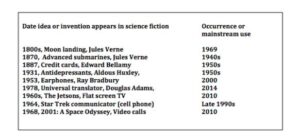How can organisations proactively look forward to identify future opportunities and threats? This series of five short think pieces examines some of the key ways that organisations can reduce the level of uncertainty surrounding what’s next.
# 5: Drilling down to reveal the real why
Author: Richard Watson

What else can you do to see the future early? One trick is to ask what’s really behind recent developments. What are the deep technological, regulatory of behavioural drivers of change? But don’t stop there.
Dig down beyond the shifting sands of popular trends to uncover the hidden bedrock upon which new developments are being built. Then balance this out against the degree of associated uncertainty.
Other tips might include travelling to parts of the world that are in some way ahead technologically or socially. If you wish to study the trajectory of ageing or robotics, for instance, Japan is a good place to start. This is because Japan is the fastest ageing country on earth and has been curious about robotics longer than most. Japan is therefore looking at the use of robots to replace people in various roles ranging from kindergartens to aged-care.
You can just read about such things, of course. New Scientist, Scientific American, MIT Technology Review, The Economist Technology Quarterly are all ways to reduce your travel budget, but seeing things with your own eyes tends to be more effective. Speaking with early adopters (often, but not exclusively younger people) is useful too as is spending time with heavy or highly enthusiastic users of particular products and services.
Academia is a useful laboratory for futures thinking too, as are the writings of some science fiction authors. And, of course, these two worlds can collide. It is perhaps no coincidence that the sci-fi author HG Wells studied science at what was to become Imperial College London or that many of the most successful sci-fi writers, such as Isaac Asimov and Arthur C. Clarke, have scientific backgrounds.
So find out what’s going on within certain academic institutions, especially those focussed on science and technology, and familiarise yourself with the themes the best science-fiction writers are speculating about.

Will doing any or all of these things allow you to see the future in any truly useful sense? The answer to this depends upon what it is that you are trying to achieve. If you aim is granular – to get the future 100% correct – then you’ll be 100% disappointed. However, if you aim is to highlight possible directions and discuss potential drivers of change there’s a very good chance that you won’t be 100% wrong.
Thinking about the distant future is inherently problematic, but if you spend enough time doing so it will almost certainly beat not thinking about the future at all.
Moreover, creating the time to peer at the distant horizon can result in something more valuable than planning or prediction. Our inclination to relate discussions about the future to the present means that the more time we spend thinking about future outcomes the more we will think about whether what we are doing right now is correct. Perhaps this is the true value of forecasting: It allows us to see the present with greater far clarity and precision.
This post was written by Richard Watson, who works with the Technology Foresight Practice at Imperial College.


